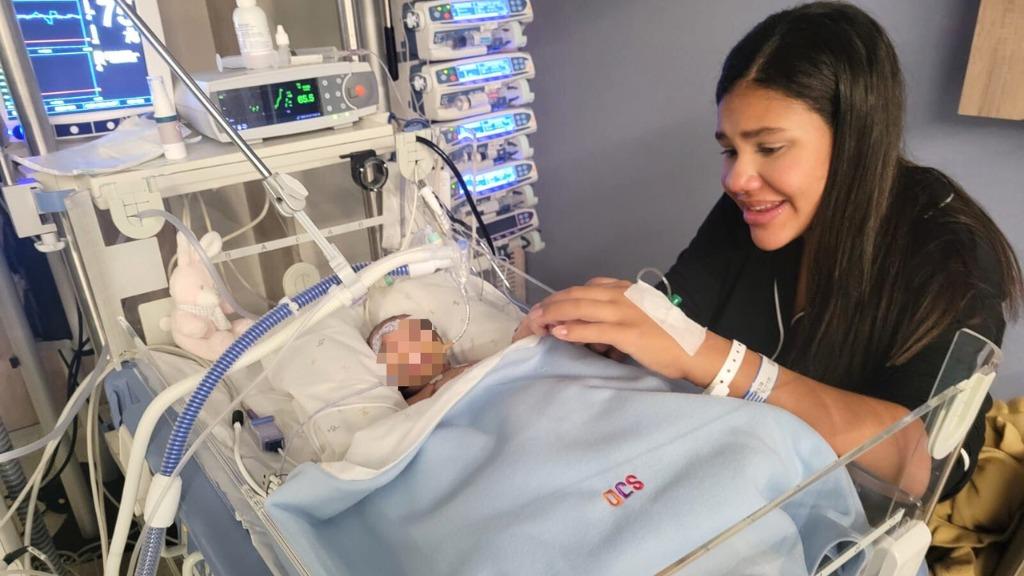‘We were seen so quickly at SJD, and that is key when you are expecting a baby with a diaphragmatic hernia’

Nicole explains why she decided to travel to Barcelona from the Dominican Republic to give birth and treat her baby at the SJD Barcelona Children’s Hospital.
When Nicole fell pregnant and found out she was expecting a girl, she knew straight away that she would name her Montserrat. Back then, she did not know that that was the name of the patron saint of Catalonia, where she would be travelling to just a few months later—all the way from the Dominican Republic—to save the child she was carrying.
‘It was a very difficult pregnancy’, recalls Nicole. ‘I was very unwell, bed-ridden. I was dehydrated and had to be hospitalised several times. But I was never worried about my baby because every check-up came back fine.’
It was at the 30-week mark when the alarm bells started to ring. In a Doppler ultrasound, Nicole's medical team saw that the baby's heart was displaced to the right. ‘That's when the nightmare began’, she recalls. ‘At first, they thought it was a cardiopathy, but after several specialist consultations and an MRI, we learned that she had a diaphragmatic hernia.’
What is a congenital diaphragmatic hernia?
It is a problem with the diaphragm that causes abdominal organs such as the stomach, intestines and liver to be pushed up higher into the chest, compressing the lungs. In Montse’s case, as well as displacing her heart, her diaphragmatic hernia had also compressed her left lung, which had caused the organ to develop incorrectly.
Although the risk varies from case to case, a diaphragmatic hernia is always a severe condition. Treatment varies based on time of diagnosis and the degree of herniation. If a severe diaphragmatic hernia is detected early, fetal medicine professionals can begin treating the child during pregnancy. This involves a fetoscopic tracheal occlusion procedure to ensure proper lung development and increase survival rates.
This, however, was not the most advisable option for Montse. Specialists in her home country considered the best option was to treat Montse after she was born, because her diaphragmatic hernia was moderate, bordering on severe. ‘There are very good doctors in my country, but, unfortunately, there is no tertiary care hospital with the technology needed to carry out this procedure or handle the possible complications that could happen. Doctors told me that I had two options: either go to Spain, as there are experts in diaphragmatic hernia operations there, or go to the United States’, she explains.
Desperate, the young woman was in a race against time to save her baby. She contacted hospitals in Spain, the United States, Argentina and Colombia, before finally deciding on the SJD Barcelona Children's Hospital. ‘All of the contact I had with the hospital was very good, and it was quick and easy to access medical care. The staff at the SJD Barcelona Children's Hospital were so fast giving us the care and information we needed, and that is extremely important when you are expecting a baby with a diaphragmatic hernia, because time really is working against you’, she notes.
The road to SJD
Her decision made, she got started with the bureaucratic processes needed to travel to Spain. On 11 October 2024, she landed in Barcelona, and two weeks later, on 28 October, Montse was born after a planned Caesarean.
The infant was immediately placed on respiratory support, and had surgery two days later. A combined team of surgeons, anesthesiologists, neonatal and nursing specialists repositioned the displaced organs—her stomach, spleen and intestines—and closed the hole in the patient's diaphragm. The girl quickly recovered after surgery. ‘She's a little warrior. She was only kept in the Neonatal Care Unit for 18 days, when patients are normally kept in for two months’, explains the mother, proudly.
Nicole is extremely grateful for how she was treated at SJD, and cannot help comparing with other hospitals she has previously dealt with. ‘When I arrived, I was so surprised that parents were allowed to be with their children whenever they wanted, day or night’, she recalls. ‘I came here with the mentality of my home country, where I would only be able to see my baby for 15 minutes per day and I wouldn't even be allowed to touch her. Here, I could be with her all the time, I could sleep next to her, change her nappies... I don't want to imagine what it would have been like if I weren't able to be with her.’
She was also surprised, and very grateful, for the empathy and compassion shown by staff: ‘They make you feel important, supported and looked after. If they saw me crying one day, the nurses would say “come get some air, love”, and they would bring me water or give me a cuddle. They were small gestures, but to me they meant the world, and helped me not to feel alone.’ Now the family is waiting for Montse to gain some weight and for her left lung to improve so she can withstand the flight back home.




